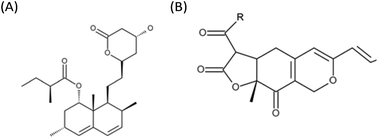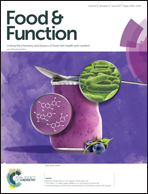Alleviation of metabolic syndrome by monascin and ankaflavin: the perspective of Monascus functional foods†
Abstract
The metabolites of Monascus with multiple benefits are popular subjects for the development of functional foods. The yellow pigments, monascin and ankaflavin, which are the constituent metabolites of M. purpureus, M. pilosus and M. ruber, are becoming the focus of research on Monascus. Monascin and ankaflavin are azaphilone compounds with similar structures that exhibit multiple beneficial effects including anti-inflammation, anti-oxidation, anti-diabetes, immunomodulation, attenuation of Alzheimer's disease risk factor, and anti-tumorigenic effects. Monascin and ankaflavin not only possess pleiotropic bioactivities, but are also more potent than monacolin K in lowering lipid levels and have lower toxicity. Monascin and ankaflavin act as the activators of PPARγ agonist/Nrf-2 that subsequently ameliorate metabolic syndrome. Following the intensive exploration of Monascus bioactivities in recent years, the focus of research on Monascus-functional foods has shifted from whole fermented products/extracts to specific bioactive compounds. Therefore, the production of monascin and ankaflavin is an important topic with respect to Monascus-functional foods. Although several genomic studies have paved the way for understanding the production of secondary metabolites in Monascus, efforts are still required to effectively manipulate the biosynthesis of secondary metabolites with genetic engineering and/or culture techniques.



 Please wait while we load your content...
Please wait while we load your content...